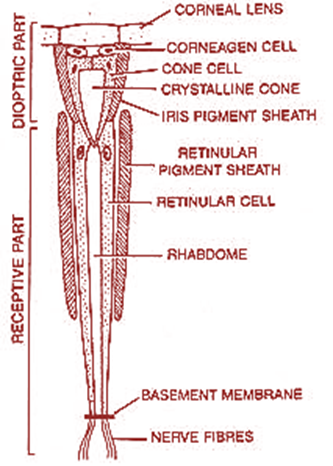
Answer
452.7k+ views
Hint: Mechanoreceptors, chemoreceptors, thermoreceptors, and photoreceptors are the sense organs of a cockroach. Ocelli and compound eyes are photoreceptors. Compound eyes are black kidney-shaped and each eye consists of 2000 functional units called ommatidia.
Complete answer:
Each ommatidium is covered externally by a transparent hexagonal cuticular facet called the cornea. It is a biconvex, transparent, refractive part of the cuticle. The cornea is secreted by a pair of specialized epidermal cells called corneagen cells (or) lenticular cells. These cells later become withdrawn to the sides of the ommatidium as primary pigment cells that form an iris pigment sheath. Cornea converges light onto a crystalline cone. Four transparent more or less conical cells called vitrellae (or) cone cells lie below the corneagen cells. They surround and secrete a transparent conical structure called crystalline cones. It focuses the light on to the next part of the rhabdome. The part of the ommatidium from the cornea up to the extreme end of the crystalline cone forms the light focusing dioptrical region. Thus, a dioptrical region of the ommatidium of cockroach involves lenticular cells, vitrellae, and crystalline cones.
Figure 1: Vertical section of ommatidium of cockroach

Additional Information: Inner ends of cone cells rest upon an elongated rod called rhabdome secreted surrounded by seven retinulae. The microvilli of each reticular cell collectively form a rhabdomere. The visual pigment is located within the microvilli. The rhabdomere fuse along the long axis of the ommatidium to form the rhabdome in the center.
So, The correct answer is Option A
Note: Inner ends of retinulae rest upon the basement membrane beyond which they are continuous with sensory nerve fibers of the optic nerve that extends up to the protocerebrum. Rhabdome and retinal cells constitute the region of the receptor of the eye. The retinulae are surrounded by seven secondary pigments cells that constitute the retinal pigment sheath.
Complete answer:
Each ommatidium is covered externally by a transparent hexagonal cuticular facet called the cornea. It is a biconvex, transparent, refractive part of the cuticle. The cornea is secreted by a pair of specialized epidermal cells called corneagen cells (or) lenticular cells. These cells later become withdrawn to the sides of the ommatidium as primary pigment cells that form an iris pigment sheath. Cornea converges light onto a crystalline cone. Four transparent more or less conical cells called vitrellae (or) cone cells lie below the corneagen cells. They surround and secrete a transparent conical structure called crystalline cones. It focuses the light on to the next part of the rhabdome. The part of the ommatidium from the cornea up to the extreme end of the crystalline cone forms the light focusing dioptrical region. Thus, a dioptrical region of the ommatidium of cockroach involves lenticular cells, vitrellae, and crystalline cones.
Figure 1: Vertical section of ommatidium of cockroach

Additional Information: Inner ends of cone cells rest upon an elongated rod called rhabdome secreted surrounded by seven retinulae. The microvilli of each reticular cell collectively form a rhabdomere. The visual pigment is located within the microvilli. The rhabdomere fuse along the long axis of the ommatidium to form the rhabdome in the center.
So, The correct answer is Option A
Note: Inner ends of retinulae rest upon the basement membrane beyond which they are continuous with sensory nerve fibers of the optic nerve that extends up to the protocerebrum. Rhabdome and retinal cells constitute the region of the receptor of the eye. The retinulae are surrounded by seven secondary pigments cells that constitute the retinal pigment sheath.
Recently Updated Pages
How many sigma and pi bonds are present in HCequiv class 11 chemistry CBSE

Mark and label the given geoinformation on the outline class 11 social science CBSE

When people say No pun intended what does that mea class 8 english CBSE

Name the states which share their boundary with Indias class 9 social science CBSE

Give an account of the Northern Plains of India class 9 social science CBSE

Change the following sentences into negative and interrogative class 10 english CBSE

Trending doubts
Fill the blanks with the suitable prepositions 1 The class 9 english CBSE

Which are the Top 10 Largest Countries of the World?

Give 10 examples for herbs , shrubs , climbers , creepers

Difference Between Plant Cell and Animal Cell

Difference between Prokaryotic cell and Eukaryotic class 11 biology CBSE

The Equation xxx + 2 is Satisfied when x is Equal to Class 10 Maths

Change the following sentences into negative and interrogative class 10 english CBSE

How do you graph the function fx 4x class 9 maths CBSE

Write a letter to the principal requesting him to grant class 10 english CBSE



